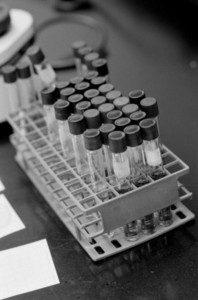Spanish researchers present a new method for the estimation of quality range (QR) bounds based on the variance components to account for both between-lots and within-lots variability; variance components are computed by the maximum likelihood method using a linear random model [1]. The authors have called this method QRML to differentiate it from the currently used procedure based on one sample per batch. For this, the molecular weight (Mw) and dimer content (expressed as percentage) were used as critical quality attributes (CQAs). Real data from seven batches of a commercial bevacizumab drug product were used.
New quality-range-setting method for biosimilarity assessment
Biosimilars/Research
|
Posted 10/09/2021
 0
Post your comment
0
Post your comment

To apply the QRML approach, k must be equal to 3 to assure that all observations will be inside the QR limits with a high probability. Overall, the bevacizumab mean Mw was 148.79 kDa; within-batch standard deviation ranges from 0.294 to 2.07 (coefficient of variation from 0.26% to 1.38%). Overall bevacizumab mean dimer content was 1.539%, and the within-batch standard deviation ranged from 0.034% to 0.198% (coefficient of variation from 2.30% to 12.7%).
For both CQAs, the null hypothesis H0:σ_B^2=0 was accepted because the 95% confidence intervals include the zero value. Therefore, at least taking the precision of the analytical methods into account, there are no differences between batches and the observed variability is due to within-batch factors. These are mainly analytical method uncertainty and sampling variability. To demonstrate that the QRML method provides more reliable results than those given by the one in use to date (QR approach is based on one sample per batch) the expected distribution of the latter using a stratified bootstrap sampling (one sample per batch; 2,000 simulations) from the experimental data were computed. The results show clearly that the QR bounds are negatively correlated. The importance of within-batch variability (σB) can be easily analyzed if QRML approach is expressed as a function of the intra-class correlation coefficient (ρ). For example, σB = 2.50 and ρ = 0.1 the QR bounds obtained were 76.3–1123., whereas for ρ = 0.5, the QR bounds were narrower (89.4, 110.6).
The relevance of the uncertainty of the analytical method can be anticipated from a proper validation procedure. Uncertainty of the Mw determination already published is of the same order of magnitude as the value estimated for σ. However, some discrepancy in the determination of dimer content were found. In this case, the values obtained were larger than expected from the validation of the analytical method. This is probably because aggregation can take place after filling vials, leading to a larger sample-to-sample variability. Therefore, interpretation of the uncertainty of the analytical model leads us to the biosimilarity design.
In conclusion, this approach facilitates calculation of more precise QR values through the maximum likelihood method, as well as for setting a priori values for QR.
Conflict of interest
The authors of the research paper [1] declared that there was no conflict of interest.
Abstracted by Alexis Manuel Oliva Martín, Departamento de Ingeniería Química y Tecnología Farmacéutica, Facultad de Farmacia, Universidad de La Laguna, 38200 Tenerife, Spain.
GaBI Journal Citation Impact
1.9 – CiteScore 2020 (calculated on 5 May 2021)
1.9 – CiteScoreTracker 2021 (Last updated on 4 August 2021)
Submit a manuscript to GaBI Journal
Related articles
Assessment of biosimilarity under the BPCI Act
Safety assessment of biosimilars in Europe: a regulatory perspective
| LATIN AMERICAN FORUM The brand-new section the ‘Latin American Forum’ on GaBI has been launched. The objective of this new section is to provide you with all the latest news and updates on developments of generic and biosimilar medicines in Latin America in Spanish. View this week’s headline article: Conocimiento y percepciones de la denominación de biosimilares en EE. UU. Browse the news in the Latin American Forum! Register to receive the GaBI Latin American Forum newsletter. Inform colleagues and friends of this new initiative. LATIN AMERICAN FORUM Se ha lanzado la nueva sección del ‘Foro Latinoamericano’ sobre GaBI. El objetivo de esta nueva sección es brindarle las últimas noticias y actualizaciones sobre desarrollos de medicamentos genéricos y biosimilares en América Latina en español. Vea el artículo principal de esta semana: Conocimiento y percepciones de la denominación de biosimilares en EE. UU. Explore las noticias en el Foro Latinoamericano! Regístrese para recibir el boletín informativo GaBI Latin American Forum. Informe a colegas y amigos sobre esta nueva iniciativa. |
Reference
1. Oliva A, Llabrés M. New quality-range-setting method based on between- and within-batch variability for biosimilarity assessment. Pharmaceuticals 2021;14(6):527.
Permission granted to reproduce for personal and non-commercial use only. All other reproduction, copy or reprinting of all or part of any ‘Content’ found on this website is strictly prohibited without the prior consent of the publisher. Contact the publisher to obtain permission before redistributing.
Copyright – Unless otherwise stated all contents of this website are © 2021 Pro Pharma Communications International. All Rights Reserved.
News
FDA approves six denosumab biosimilars
EMA recommends approval for four biosimilars targeting three therapies
General
Samsung Bioepis wins Pyzchiva case; Regeneron patent rulings threaten foreign biosimilars
Chinese biosimilars go global: growth, partnerships, and challenges
What is the future for the US biosimilar interchangeability designation

Biosimilars/Research Posted 05/06/2025
Biosimilar clinical efficacy studies: are they still necessary?

Biosimilars/Research Posted 27/05/2025
The best selling biotechnology drugs of 2008: the next biosimilars targets








Post your comment